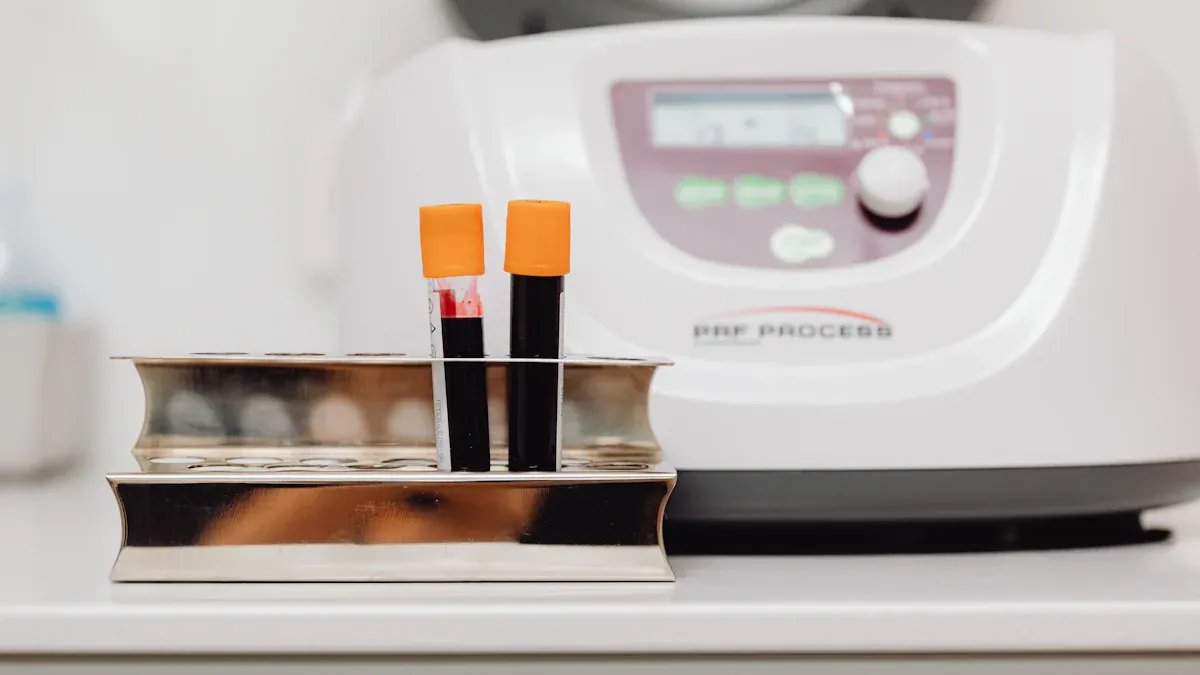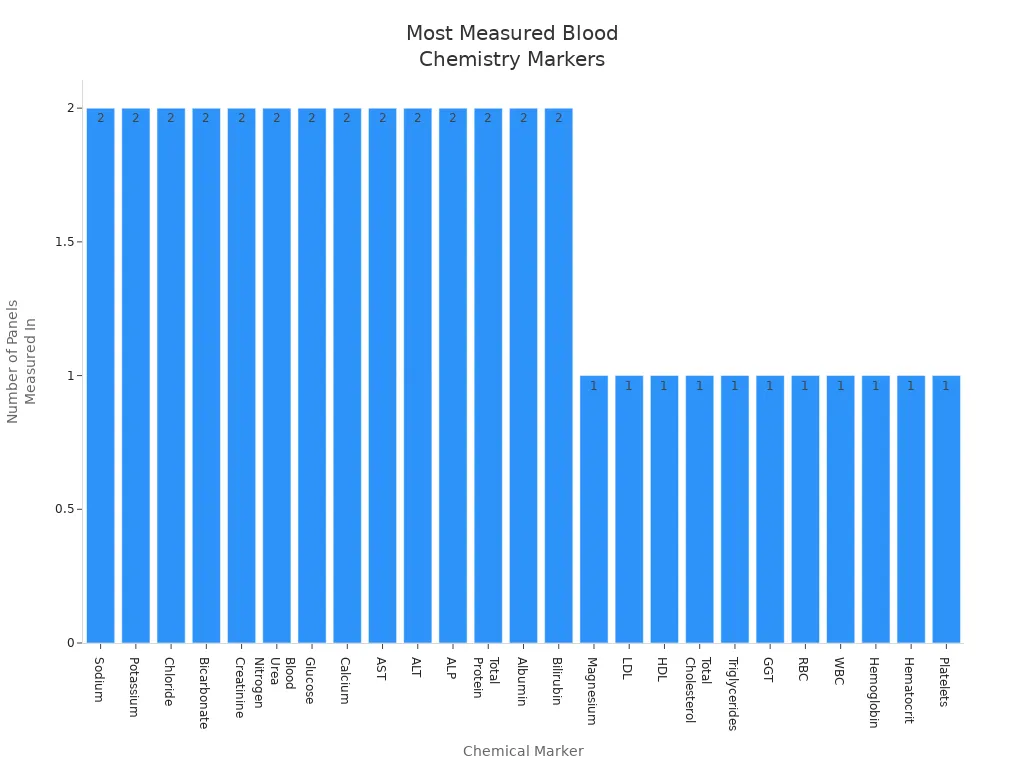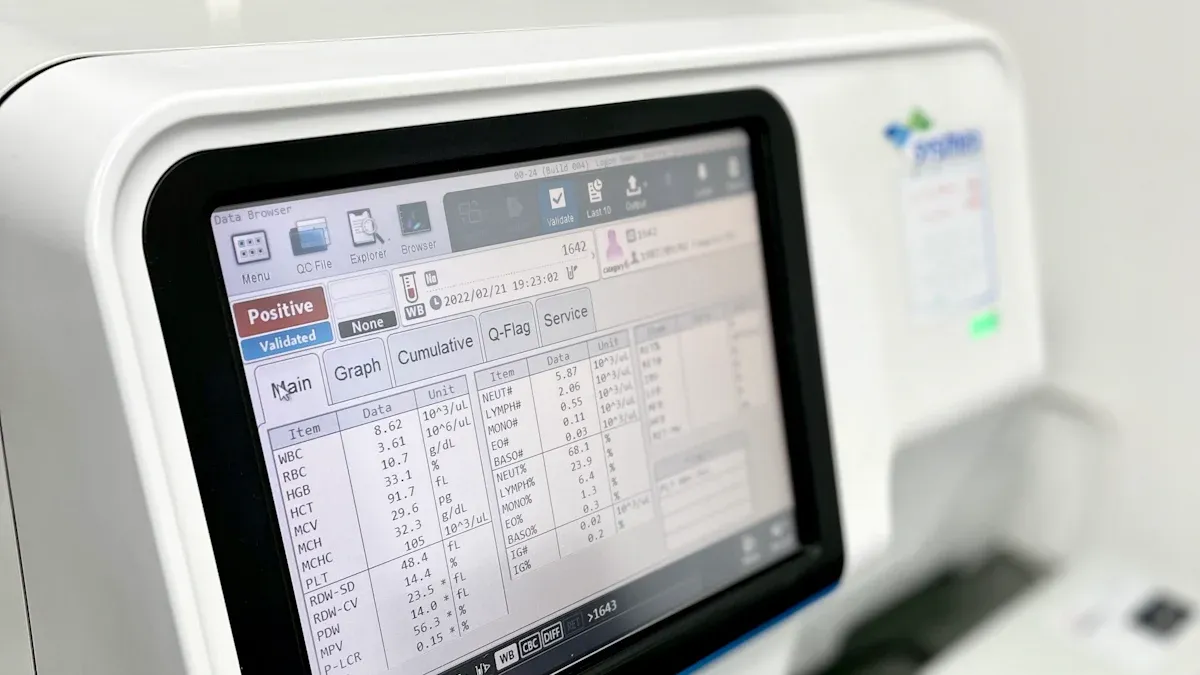Views: 0 Author: Site Editor Publish Time: 2025-08-12 Origin: Site










A blood chemistry analyzer checks for chemicals in blood like glucose, electrolytes, and proteins. A hematology analyzer counts blood cells such as red blood cells, white blood cells, and platelets. Hospitals use both machines to get quick and correct results for patients.
Analyzer Type | Main Function | Usage Rate (2024) |
|---|---|---|
Blood Chemistry Analyzer | Checks for chemicals in blood | 46.8% market share |
Hematology Analyzer | Counts blood cells | 46.25% market share |
Knowing these differences helps labs pick the best tool for each test.
Blood chemistry analyzers look at chemicals in blood. They help doctors check how organs are working. Hematology analyzers count blood cells and look at their shapes. They help find problems with blood.
Blood chemistry analyzers use serum or plasma from blood. Hematology analyzers use whole blood to study the cells. They also look at the shapes of the cells.
Both analyzers help doctors find health problems fast. They help doctors make good choices for patient care.
New analyzers use smart machines and computers. This helps labs get results quickly and correctly. It also helps stop mistakes.
Labs pick the analyzer that fits their needs best. They think about what samples they have and what tests they need. This helps patients get the best care.

A blood chemistry analyzer looks for many chemicals in blood. It usually tests serum or plasma. Sometimes it can use whole blood too. Serum and plasma are used most because they give clear results. Whole blood is good when labs need to work fast. The analyzer checks for important things like:
Electrolytes: sodium, potassium, chloride, bicarbonate
Kidney function: creatinine, blood urea nitrogen
Liver function: total protein, albumin, globulins, bilirubin, AST, ALT, GGT, ALP
Cardiac markers: troponin, CK-MB, myoglobin, BNP
Minerals: calcium, magnesium, phosphate
It also checks glucose, cholesterol, and other proteins. These things help doctors see how organs are working and if there are any problems.
Doctors use a blood chemistry analyzer for many tests. Some of the most common ones are:
Test Panel | What It Measures | Why It Matters |
|---|---|---|
Basic Metabolic Panel (BMP) | Electrolytes, kidney markers, glucose, calcium | Checks kidney function, sugar, salts |
Comprehensive Metabolic Panel (CMP) | BMP plus liver enzymes, proteins, magnesium, bilirubin | Monitors liver, kidney, and minerals |
Lipid Panel | Cholesterol (LDL, HDL, total), triglycerides | Assesses heart disease risk |
Cardiac Biomarkers | Troponin, CK-MB, myoglobin, BNP | Detects heart damage |
Coagulation Panel | Blood clotting factors | Monitors bleeding or clotting issues |

Hospitals use a blood chemistry analyzer to check for diabetes and kidney disease. It also helps find liver problems and heart attacks. Doctors use it to see if someone has an infection or a mineral problem. It can also show if a person might get heart disease. The analyzer gives results quickly so doctors can help fast.
A blood chemistry analyzer uses special tools to measure chemicals in blood. It often uses spectrophotometry. This checks how much light a sample takes in after adding a special liquid. The color change tells how much of a chemical is there. For electrolytes, it uses ion-selective electrodes. These sensors react to certain ions and make a voltage. The voltage matches the amount of the ion. Some analyzers use potentiometry. This measures electrical potential to find out how much of something is in the sample. These ways help labs get results that are fast and correct.

A hematology analyzer looks at the cells in blood. It uses whole blood or blood that is already mixed with liquid. It mainly checks red blood cells, white blood cells, and platelets. These cells help carry oxygen, fight germs, and stop bleeding. The analyzer also checks cell size and shape. It can find special cells like reticulocytes and nucleated red blood cells.
Cellular Component | Measurement Parameters | Biological Role | Diagnostic Impact on Patient Care |
|---|---|---|---|
Red Blood Cells (RBC) | Count, shape, volume, reticulocytes | Carry oxygen and carbon dioxide | Low RBC count shows anemia; reticulocyte count helps find the cause of anemia |
White Blood Cells (WBC) | Count, shape, volume, nucleated RBCs | Immune defense cells | High WBC count suggests infection; low WBC count may show viral infection or effects of cancer treatment |
Platelets (PLT) | Count, size (mean platelet volume) | Help blood clot | Abnormal counts or size can signal bleeding problems or affect WBC counts |
Doctors use hematology tests to check for health problems. The most common test is called a Complete Blood Count. This test gives a full look at blood health. It checks red blood cells, white blood cells, and platelets. Hemoglobin and hematocrit show how well blood carries oxygen. Red blood cell indices help find out what kind of anemia someone has. White blood cell differential counts show how the immune system is working. Platelet count and mean platelet volume check if blood can clot. Partial thromboplastin time checks how fast blood clots.
Hematology analyzers help doctors find many diseases. They can find anemia, including sickle cell anemia and thalassemia. They also help find infections from bacteria or viruses. Leukemia and lymphoma can be found with these tests. Platelet problems that cause bleeding or raise stroke risk can be found too. The analyzer can also help find liver and kidney problems. These results help doctors choose the right treatment and watch how patients are doing.
Hematology analyzers use special tools to study blood cells. Impedance technology counts and sizes cells by checking electrical resistance. Cells pass through a tiny hole, and the machine measures them. Flow cytometry uses lasers to shine light on cells. It measures how the light bounces off to show cell size and shape. Some analyzers use both ways to get better results. They can also use dyes to make cell parts easier to see. These tools help labs find odd cells, spot infections, and catch blood cancers early. Newer analyzers use smart software to sort cells and fix mistakes. This makes results faster and more correct.
Blood chemistry analyzer and hematology analyzer do different jobs. One looks for chemicals in blood. The other counts and checks blood cells. They use different ways to test blood. Each machine studies a different part of blood.
Blood chemistry analyzer finds chemical markers like glucose and enzymes. Hematology analyzer counts red blood cells and platelets.
Labs use both machines to help patients. Each machine has its own job.
Here is a table that shows how they are different:
Parameter Aspect | Hematology Analyzer | Blood Chemistry Analyzer |
|---|---|---|
Sample Type | Whole blood, cellular components | Serum, plasma, urine |
Measurement Focus | Blood cells, cell counts, morphology | Chemical substances, organ function, metabolism |
Typical Parameters | RBCs, WBCs, platelets, hemoglobin, hematocrit | Liver enzymes, bilirubin, urea, creatinine, lipids, glucose |
Diagnostic Purpose | Detect blood disorders, cell abnormalities | Assess organ function, metabolic status |
Labs pick samples based on the test they need.
Hematology analyzers use whole blood. They check cells and their shapes.
Blood chemistry analyzer uses serum or plasma. It looks for chemicals and proteins.
Some chemistry analyzers can test urine too.
Tip: Picking the right sample helps labs get good results.
Hematology analyzers help doctors find blood problems. They show if someone has anemia or infection. These machines count cells fast and find odd cells.
Blood chemistry analyzer checks organs for problems. It measures enzymes and glucose. Doctors use it to find diabetes and heart disease.
Clinical chemistry analyzers help with diseases like diabetes and sepsis. Hematology analyzers help labs by counting cells and making care better.
Hematology analyzers look at blood cells. Blood chemistry analyzer checks chemical markers.
Analyzer Type | What It Measures | Sample Type | Common Tests | Clinical Uses | Notable Features |
|---|---|---|---|---|---|
Hematology Analyzer | RBCs, WBCs, platelets, hemoglobin | Whole blood | CBC, differential, reticulocyte | Anemia, infection, leukemia, bleeding | Blast flagging, cell morphology |
Blood Chemistry Analyzer | Glucose, enzymes, electrolytes | Serum, plasma | BMP, CMP, lipid panel, cardiac | Diabetes, kidney, liver, heart disease | Ion-selective electrodes, spectrophotometry |
Labs choose the analyzer based on what they want to find.
Hematology analyzers are best for blood cell problems and infections.
Blood chemistry analyzer works for organ health and chronic diseases.
Labs think about speed, cost, and test choices before picking.
Picking the right analyzer helps labs give quick and correct results.
Modern analyzers use smart machines to help labs work better. Hematology analyzers now use AI to handle lots of data. AI helps labs finish tests faster and need less hand work. These machines count cells using electricity and light. They also use special ways to count platelets and fix mistakes. Some systems warn staff if a sample needs to be checked by hand. This keeps results safe and correct. Automation lets labs test more samples each day. It also gives workers more time for other jobs.
Labs need fast and correct results to help patients. Clinical chemistry analyzers often give results on time. They are almost six times more likely to do this than hematology analyzers. New hematology analyzers can test up to 60 samples in one hour. They have built-in checks to keep results right and lower mistakes. Most mistakes happen before the test, not during it. Automated analyzers give results that match hand testing. Labs can trust both blood chemistry analyzer and hematology test results.
Tip: Doing regular checks and care keeps analyzers working well and results fast and correct.
Both analyzer types can connect to lab computers and health records. They use network, serial, or file connections. Most labs use HL7 rules to send data right away. This lets labs send results to doctors fast and cuts down on typing. Connecting analyzers helps labs report faster and make fewer mistakes. It also helps labs keep track of samples and data.
Interface Type | Description | Use Case Example |
|---|---|---|
Network-Based | Sends data over a local network | Used in new clinical labs |
Serial-Based | Connects old analyzers with serial cables | Used for older devices |
File-Based | Moves data files like HL7 or ASTM to lab computers | Used for analyzers that need special support |
Labs need to think about many things when picking an analyzer. Price depends on what the analyzer can do. Bigger machines cost more but test more samples. Labs must clean, check, and update analyzers often. Workers need training to use and fix them. Labs should pick an analyzer that matches how many samples they have. Small labs may pick small models like Beckman Coulter DxH 560 AL. Bigger labs may need machines that can grow with them. Brand, help, and how well it connects also matter. Picking and caring for the right analyzer saves money and helps patients.
Blood chemistry analyzer looks for chemicals in blood. Hematology analyzers count and check blood cells. These tools help doctors find different health issues. Blood chemistry analyzer is good for organ and body tests. Hematology analyzers are better for blood problems and infections.
Practical advice for choosing the right analyzer:
Work with lab experts to make good choices.
Ask professionals when changing test plans.
Let doctors and lab staff talk directly.
Do not repeat tests if not needed.
Make sure important tests are done quickly.
Use teams from different fields for the best results.
Trend Aspect | Description & Examples |
|---|---|
Automation & User Convenience | Analyzers use bar codes and easy modes to lower mistakes. |
Expanded Analytical Range | Systems can do many tests like chemistry and immunoassays. |
Throughput & Speed | Some analyzers can do up to 1,800 tests each hour. |
Integration & Scalability | Workcells can run many kinds of tests together. |
Cost & Resource Optimization | Using one workstation saves money and helps labs work better. |
Software & Connectivity | Easy software and remote help make data easier to understand. |
Adaptability to Settings | These solutions work for labs of any size or place. |
Reagent Continuity & Standardization | The same reagents work in many analyzers for steady results. |
Future Directions | Smaller analyzers and more test choices help labs keep up with new needs. |
Healicom Medical has advanced analyzers for all lab sizes. It gives strong solutions and expert help. Contact Healicom Medical to make your lab better.
A blood chemistry analyzer checks for chemicals in blood. A hematology analyzer counts and looks at blood cells.
Each tool helps doctors find different health problems.
Most analyzers only do one kind of test. Some new machines can do both, but most labs use two machines for better results.
Analyzer Type | Sample Needed |
|---|---|
Blood Chemistry Analyzer | Serum or plasma |
Hematology Analyzer | Whole blood |
Each analyzer works best with the right sample.
Labs need both because each gives different facts. Blood chemistry analyzers show how organs are working. Hematology analyzers show if blood cells are healthy.
Most new analyzers give results in just a few minutes.
Blood chemistry analyzers usually finish tests in 10 to 20 minutes.
Hematology analyzers can check up to 60 samples every hour.


